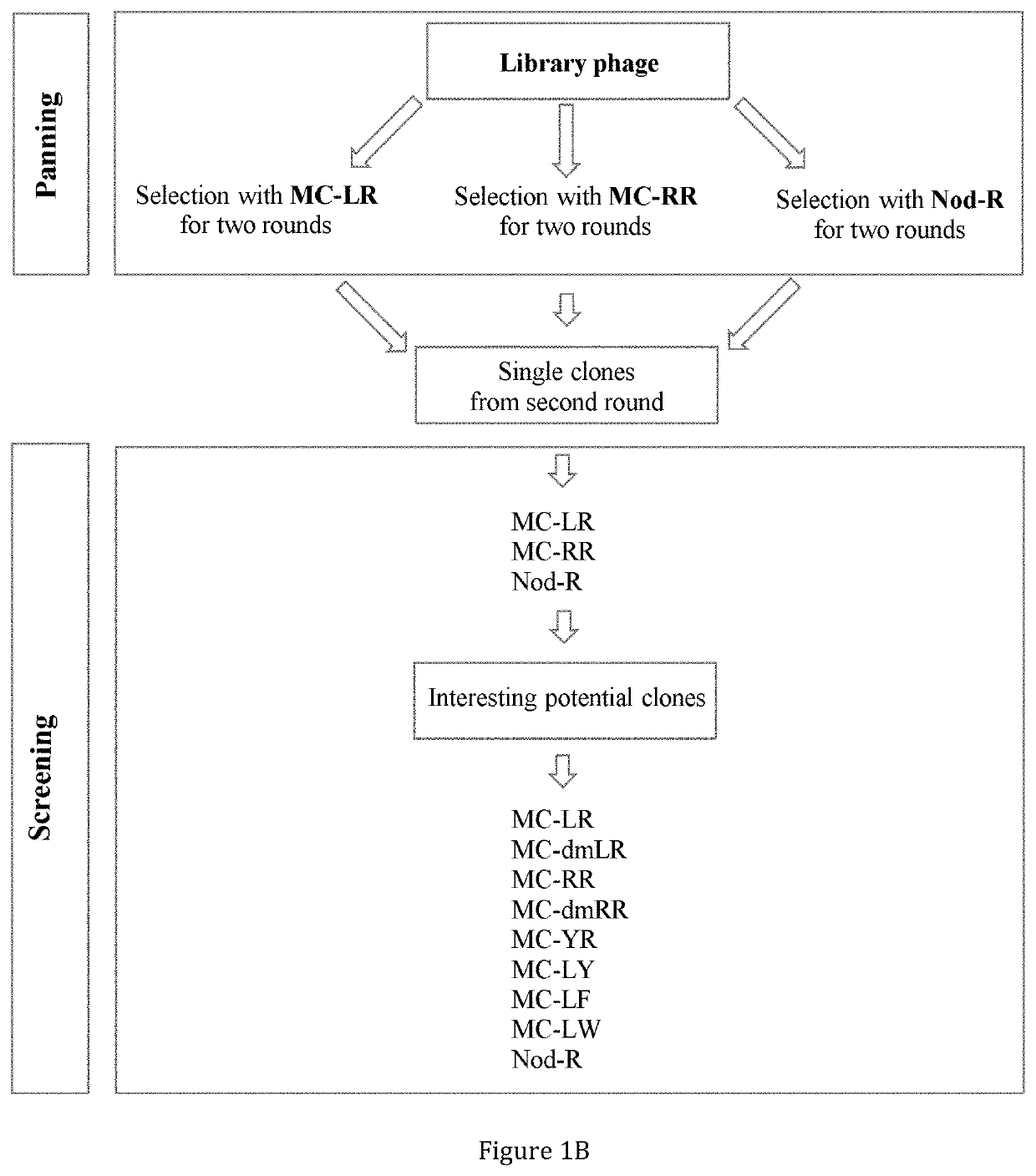Antibodies against immunocomplexes comprising cyanobacterial cyclic peptide hepatotoxins
a technology of cyanobacteria and immunocomplex, which is applied in the field of detection of cyanobacteria cyclic peptide hepatotoxins, can solve the problems of cyanobacteria toxins, animal poisoning, and human health risk, and achieve the effect of reducing the number of immunocomplexes
- Summary
- Abstract
- Description
- Claims
- Application Information
AI Technical Summary
Benefits of technology
Problems solved by technology
Method used
Image
Examples
example 1
n of Anti-IC Antibodies
Materials and Methods
Common Materials, Instruments and Reagents
[0136]Common inorganic and organic chemical reagents were obtained from commercial source either Sigma or Merck unless otherwise specified. The water used was purified by Millipore Milli-Q Plus water filtration purification system (Millipore Corporation, country). Restriction enzymes were either from Fermentas (Vilna, Lithuania) or from New England Biolabs (Ipswich, UK). Oligonucleotides were custom-synthesized by Tag Copenhagen or biomers.net. Molecular biology techniques were performed according to the standard protocols (Sambrook and Russell, 2001) if not mentioned. DNA manipulation kits were from Qiagen (Hamburg, Germany) or from Thermo Scientific (Fisher Scientific, Finland). Streptavidin-coupled magnetic beads (Dynabeads® MyOne™ Streptavidin C1, and Dynabeads® M-280 Streptavidin) and Dynal MPC magnet were purchased from Invitrogen Dynal AS, Oslo, Norway. Multilabel counter Victor™ 1420 for fl...
example 2
ep Non-Competitive Time-Resolved Immuno-Fluorometric Assay
[0154]This example demonstrates the use of an anti-IC antibody according to the present invention in a single-step non-competitive (i.e. sandwich) time-resolved immunofluorometric (TR-IFMA). The assay was validated with spiked as well as with environmental water samples.
Materials and Methods
Toxin Standards
[0155]Specific amount of the purified toxins: MC-LR, dm-MC-LR, MC-RR, dmMC-RR, MC-YR, MC-LY, MC-LF, MC-LW, Nod-R (FIG. 1A) were obtained from Dr. Meriluoto's Lab (Åbo Akademi University) as a lyophilized dried powder. The toxins were purified by preparative HPLC (Column: Nucleosil C 18 250×21 mm, 7 μm particles, Eluent: 27% ACN and 73% 0.013 M ammonium acetate). Toxin identification was done in fractions and purity was checked on analytical HPLC. Concentration was done on SPE cartridges. Second purification was done on a semi-preparative HPLC column when needed. Purity was checked on LC-MS (ion trap HCT Ultra) and determinat...
example 3
ep Non-Competitive Chromogenic Assay
[0169]This example demonstrates that the present anti-IC antibodies are suitable also for use in a chromogenic non-competitive ELISA assay.
[0170]Biotinylated anti-Adda mAb (50 ng) and 200 ng of SA51D1 scFv-alkaline phosphatase fusion protein in 100 μL of PBS, pH 7.4 buffer were dispensed in streptavidin-coated 96-well microtiter plate (Kaivogen, Turku, Finland) together with 100 μL of each nine different CCPH standard (FIG. 1A) solutions ranging from 0.003 to 30 μg / L as duplicates. Wells were incubated in shaking at room temperature for one hour and then washed for four times. Color formation was started by adding 200 μL of para-Nitrophenylphosphate Liquid Substrate System (Sigma Aldrich, USA). Color formation was measured at different time points from 1 hour to 19 hours by reading absorbance at 405 nm with Victor multilabel counter (Perkin-Elmer Wallac, Turku, Finland).
[0171]Results shown in FIG. 6 illustrate that the single-step ELISA assay with...
PUM
| Property | Measurement | Unit |
|---|---|---|
| incubation time | aaaaa | aaaaa |
| concentration | aaaaa | aaaaa |
| concentration | aaaaa | aaaaa |
Abstract
Description
Claims
Application Information
 Login to View More
Login to View More - R&D
- Intellectual Property
- Life Sciences
- Materials
- Tech Scout
- Unparalleled Data Quality
- Higher Quality Content
- 60% Fewer Hallucinations
Browse by: Latest US Patents, China's latest patents, Technical Efficacy Thesaurus, Application Domain, Technology Topic, Popular Technical Reports.
© 2025 PatSnap. All rights reserved.Legal|Privacy policy|Modern Slavery Act Transparency Statement|Sitemap|About US| Contact US: help@patsnap.com



